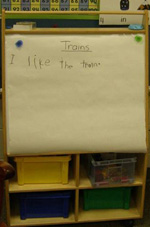Every teacher knows the best plans in the world are only as valuable as the paper they are on, when asked to stand alone. Great lessons in the classroom are taught, reviewed, and practiced and writing isn't the exception. Students need clear, concise directions for writing that are consistent and deliberate. When writing is taught in this manner, students can thrive.
Students should start from a successful point and writing should increase in difficulty and rigor throughout the year. Each student will have individual starting points and individual growth, but class whole-group lessons will benefit all. Students may start with writing their names, progress to writing predicable text and repetitive sentences, to constructing stories at varying lengths.
Teachers who have a plan for writing, can help their students plan, as well. Here is my year-long writing plan. For a breakdown in chart form with additional details, look here.
September (month 1)
 Whole group writing: As a group, students need to know they can write a word, a sentence, a story. Even if they are not writing their name independently, a supported whole-group experience allows writing to be a safe place for success. Certain routines need to be introduced and practiced. In my class, we have a structure for writing stories called the Sentence Maker©. I have used in my classroom for years. Students are shown a poster-sized version of the method. It provides a clear path toward a story. The first sentence is a topic sentence using newly introduced or known wordwall words. The second sentence is a sentence describing the color of the topic. The third sentence is about the size and the final sentence describes where the topic is or the setting of the story. This provides the structure for our weekly stories.
Whole group writing: As a group, students need to know they can write a word, a sentence, a story. Even if they are not writing their name independently, a supported whole-group experience allows writing to be a safe place for success. Certain routines need to be introduced and practiced. In my class, we have a structure for writing stories called the Sentence Maker©. I have used in my classroom for years. Students are shown a poster-sized version of the method. It provides a clear path toward a story. The first sentence is a topic sentence using newly introduced or known wordwall words. The second sentence is a sentence describing the color of the topic. The third sentence is about the size and the final sentence describes where the topic is or the setting of the story. This provides the structure for our weekly stories.
Our routine is a story a week:
- Monday: Topic and Topic Sentence.
- Tuesday: Color sentence.
- Wednesday: Size sentence.
- Thursday: Setting Sentence.
- Friday: Review, reread, illustrate.
From the beginning, I introduce the concept of a topic and a topic sentence. The topic is pulled from a mentor text and we add our known words to create an opening sentence. We orally decide on the sentence. We count it on our fingers, one word at a time. As we count the words, we decide on the first word. We say the word, over and over, listening for the sounds in the word. The word is written one sound at a time. Typically, I write the letter or letters on a small dry erase board, while the students write it on the carpet and one child will write it on the paper. I provide oral reading and handwriting directions at the same time. After we write each word, we use our spacer as a pointer and read what we have written. Then, we start again. Repeat the whole sentence, count, fold our fingers and whisper words we have already written, and decide on the next sentence.
Independent writing: If the word is on our wordwall for a week or so, one student will write the whole word. Another student is asked to find the word on the wordwall and shout the spelling to the writer. Students also work on writing names.
October, November (months 2, 3)
Whole group: Continue writing a story a week, in a whole group setting.
 Independent: During the writing center, a predictable sentence starter is provided. Students are asked to write sentences using the starter and the sound chart. They are introduced to The Big 3, the rubric for sentence mechanics. The students look for capitalization, spaces, and end marks. Students are also introduced to “The Squiggle Center” with the expectation they will write a sentence to describe their squiggle.
Independent: During the writing center, a predictable sentence starter is provided. Students are asked to write sentences using the starter and the sound chart. They are introduced to The Big 3, the rubric for sentence mechanics. The students look for capitalization, spaces, and end marks. Students are also introduced to “The Squiggle Center” with the expectation they will write a sentence to describe their squiggle.
December (month 4)
Whole group: The class continues to write stories, but students are given paper and pencil to write the stories as we create it. At the end of December, they have a book for their parents for a holiday gift.
Independent: Students are using the sentence starters and sound chart to make sentences.
January (month 5)
Whole group: Students are given a “Happy New Year” gift of a writing folder. This folder contains sheet protectors which include the sound chart, an individual wordwall word chart, a sentence starter chart and a personal Sentence Maker©. The front pocket is for incomplete stories and the back pocket is for completed stories. When students have four completed stories, they can use “fancy paper” (decorated computer paper or special themed paper) to publish a story. Published stories can be shared with family or read to special people in the building, such as the principal, the assistant principal, the guidance counselor, etc. Whole group writing becomes directed towards the science and social studies curriculum or interactive writing with reading skills, such as predicting or summarizing.
Independent: More centers are added that require writing: “First, Then, Last” and “Read it, Write it, Draw it.”
February–June (months 6—9)
Student writing becomes more and more independent. They are expected to use the Sentence Maker© when they are writing, if they need it. If they outgrow it, they do not need to use it. They are given free rein on topic choice and story length. At the end of the day, completed stories are shared with the class. Children’s “requirements” are differentiated during writing conferences.
By incorporating writing into every part of our day, I am thrilled to see students grow with writing skills. Before you know it, they enjoy writing time and call themselves “authors.”
 Cathy Collier is a reading specialist at Great Bridge Primary School in Chesapeake, Virginia with an additional 15 years as a kindergarten teacher. She has her B.S. in Special Education, a master’s degree in Special Education and a certified reading specialist. She is the immediate past president of the Virginia State Reading Association.
Cathy Collier is a reading specialist at Great Bridge Primary School in Chesapeake, Virginia with an additional 15 years as a kindergarten teacher. She has her B.S. in Special Education, a master’s degree in Special Education and a certified reading specialist. She is the immediate past president of the Virginia State Reading Association.